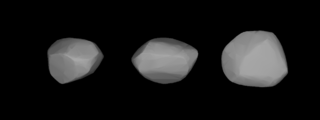Related Research Articles

Dejanira is a main belt asteroid that was discovered by Alphonse Borrelly on 1 December 1875, and named after the warlike princess Deianira in Greek mythology. The Dejanira family of asteroids is named after it.

Koronis is a main-belt asteroid that was discovered by Russian astronomer Viktor Knorre on January 4, 1876, from the Berlin observatory. It was the first of his four asteroid discoveries. The meaning of the asteroid name is uncertain, but it may come from Coronis the mother of Asclepius from Greek mythology. Alternatively, it may come from Coronis, a nymph of the Hyades sisterhood. The Koronis family is named after this asteroid.

Ambrosia is a main belt asteroid that was discovered by the Corsican-born French astronomer J. Coggia on February 28, 1879, and named after Ambrosia, the food of the gods in Greek mythology.

Oceana is an asteroid from the asteroid belt. It was discovered by Austrian astronomer Johann Palisa on 30 March 1882, in Vienna. It was named after the Pacific Ocean. Based upon its spectrum, it is classified as an M-type asteroid, but is not metallic.

Kriemhild is a main belt asteroid that was discovered by Austrian astronomer Johann Palisa on 22 September 1884 in Vienna and was named after Kriemhild, a mythological Germanic princess, by Moriz von Kuffner, a Viennese industrialist and sponsor of astronomy.

Atropos is a typical Main belt asteroid that was discovered by Austrian astronomer Johann Palisa on 8 March 1888 in Vienna.

Eduarda is a main belt asteroid that was discovered by German astronomer Max Wolf on 25 September 1892 in Heidelberg. It was named after German banker and amateur astronomer Heinrich Eduard von Lade.

Ducrosa is a typical Main belt asteroid. It was discovered by Auguste Charlois on 15 March 1895 in Nice.
Laodica is a minor planet orbiting the Sun.
Brixia is a relatively large minor planet, specifically an asteroid orbiting mostly in the asteroid belt that was discovered by American astronomer Raymond Smith Dugan on January 10, 1904. The name derives from Brixia, the ancient name of the Italian city of Brescia.
Cheruskia is a minor planet, specifically an asteroid orbiting in the asteroid belt that was discovered by German astronomer Paul Götz on 26 July 1905 from Heidelberg.

Recha is a minor planet, specifically an asteroid orbiting in the asteroid belt between Mars and Jupiter. The asteroid, discovered by German astronomer Max Wolf on September 19, 1905, was named after a character in Gotthold Ephraim Lessing's play Nathan the Wise and may have been inspired by the asteroid's provisional designation 1905 RC.
Bilkis is a minor planet, specifically an asteroid orbiting in the asteroid belt. It was discovered by German astronomer August Kopff in 1906 February and was given the Koran name for the Queen of Sheba. Photometric observations at the Palmer Divide Observatory in Colorado Springs, Colorado in 2006–7 were used to build a light curve for this object. The asteroid displayed a rotation period of 8.5742 ± 0.0005 hours and a brightness variation of 0.40 ± 0.02 in magnitude.

Juvisia is a minor planet, specifically an asteroid orbiting in the asteroid belt that was discovered 27 August 1906 in Heidelberg by German astronomer Max Wolf. It was named after the commune Juvisy-sur-Orge, France, where French astronomer Camille Flammarion had his observatory.
607 Jenny is a minor planet, specifically an asteroid orbiting in the asteroid belt that was discovered by German astronomer August Kopff on September 18, 1906.
620 Drakonia is a minor planet, specifically an asteroid orbiting in the asteroid belt. It was discovered October 26, 1906, in Taunton, Massachusetts, by American astronomer Joel Hastings Metcalf and given the preliminary designation 1906 WE. It may have been named for Drake University.
687 Tinette is a minor planet, specifically an asteroid orbiting primarily in the asteroid belt. It was discovered by Austrian astronomer Johann Palisa on 16 August 1909 from Vienna and was given the preliminary designation 1909 HG.

708 Raphaela is a minor planet orbiting the Sun.
880 Herba is a minor planet orbiting the Sun that was discovered by German astronomer Max Wolf on 22 July 1917 in Heidelberg.
947 Monterosa is a minor planet orbiting the Sun.
References
- ↑ Noah Webster (1884) A Practical Dictionary of the English Language
- 1 2 Yeomans, Donald K., "535 Montague", JPL Small-Body Database Browser, NASA Jet Propulsion Laboratory , retrieved 5 May 2016.
- 1 2 Buchheim, Robert K. (July 2011), "Phase Curves of 158 Koronis and 535 Montague", The Minor Planet Bulletin, vol. 38, no. 3, pp. 285–307 128–130, Bibcode:2011MPBu...38..128B.